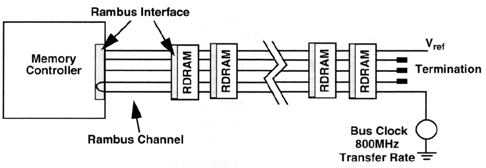Rambus DRAM: Uncovering Facts & Burying Rumors
by Anand Lal Shimpi on May 15, 2000 12:27 AM EST- Posted in
- Memory
Before we begin discussing RDRAM as a solution to this lack of memory bandwidth problem, let's talk about what exactly makes RDRAM different from SDRAM.
The technology behind RDRAM is really no different than that behind SDRAM. According to Rambus, they design high speed interfaces, not a new memory technology. In essence, that's what makes RDRAM what it is, the high speed interface that connects the RDRAM module to the outside world that is your computer.
RDRAM doesn't change the way memory is addressed or any of the fundamentals of memory storage/retrieval; instead, it manages to speed up the actual process of transferring the data from one end (RDRAM) to the other (your chipset).
The way RDRAM achieves this acceleration is by using a small interface present on the RDRAM chips themselves as well as the memory controller, which in the case of a PC is located on the North Bridge or Memory Controller Hub of the chipset.

Using these Rambus interfaces, RDRAM is capable of transferring data at up to 400MHz DDR (or double pumped), meaning that the effective transfer rate is equal to that of an 800MHz channel.
Since the current RDRAM implementation features a 16-bit (2-bytes) wide Rambus channel, we get a theoretical peak transfer rate of 800MHz x 2-bytes or 1600MB/s (1.6GB/s).
As you can guess, since this interface must be included on each RDRAM chip on a module, the die size of these modules is increased from what they would otherwise be without the high speed interface.
Fortunately, since the Rambus interface is the same regardless of what size the RDRAM chip you're using is, the percent of the device's die this interface occupies decreases as the memory size increases. Basically, the interface's size remains constant regardless of the size of the RDRAM device it is integrated with.
For example, while the interface occupied between 15 – 30% of the first 64Mbit (8MB) RDRAM chips, it assumes 10 – 20% of the die size of the larger RDRAM chips, i.e. the 128Mbit and 256Mbit chips.
Because of this, the contribution the added die size makes to the current price premium of RDRAM over SDRAM isn't too significant because most of the RDRAM modules on the market today are using 128Mbit and 256Mbit where the percentage of the die occupied by the Rambus interface is minimal.










1 Comments
View All Comments
dylan522p - Wednesday, December 11, 2013 - link
Wow I wish I read this all those years ago.